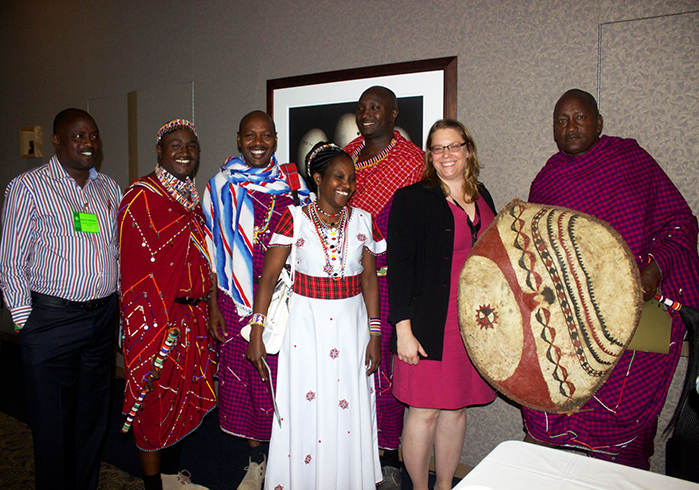“There’s a plan afoot to ship me a Maasai shield.”
So ran one of my more delightfully unexpected Facebook posts in late June. Because—really—how often does one become the recipient of such a special package? I’d had no idea earlier that day that I would play a small part in the repatriation of an important cultural object.
Let me back up. Using the backdrop of the 2014 Smithsonian Folklife Festival, the Center for Folklife and Cultural Heritage organized an international symposium around the practice and challenges of intangible cultural heritage programs. As part of this meeting (which was funded by the China International Culture Association, the Smithsonian Consortia for World Cultures, and the Human Origins Program at the National Museum of Natural History), we invited a group of six Maasai representatives from the Olorgesailie region in the South Rift Valley in southwestern Kenya.
The Maasai are one of Kenya’s most iconic cultural groups, comprised of approximately one million individuals in southern Kenya and northern Tanzania, a geographic spread sometimes referred to as “Maasailand.” A semi-nomadic group, the Maasai practice cultural traditions deeply tied to land use (though not ownership), animal care and conservation, and herding traditions. The South Rift Valley covers approximately 850 hectares (over two million acres) and includes tremendous diversity in topography and animal life.
This group of Maasai who came to the Festival, primarily staff and advisors to the South Rift Association of Land Owners (SORALO), was led by SORALO director John Kamanga. Kamanga was one of our featured speakers at the symposium.
SORALO is working all over the South Rift to accomplish a number of tasks, with the central goal of building awareness and the conservation of Maasai cultural traditions, including land use and herding. They are educating the public about the importance of Maasai artifacts and leading a repatriation effort to return sold, traded, or stolen artifacts back to Maasai tribes whenever possible. In developing the new Olorgesailie Resource Center, SORALO will be able to showcase Maasai artifacts in their proper context and educate both Maasai communities and the public about the inextricable link between Maasai culture and the land.
In explaining the shield’s background to me, Kamanga said that, during a visit to the United States a few months previously, he met an anthropologist who worked in East Africa about sixty years ago. During that time, the anthropologist acquired a Maasai shield while doing fieldwork in Tanzania (which borders Kenya to the south). After learning of SORALO’s efforts to shepherd the repatriation of Maasai objects back to Maasai communities, this collector offered to donate his shield to Kamanga at the earliest opportunity.
That opportunity came when Kamanga was in Washington, D.C., for the intangible cultural heritage symposium. He asked me about the feasibility of shipping the shield from New York—where it was temporarily housed—down here to Washington, and if I could help facilitate that. Of course I was delighted to help, and a few days later, the shield was winging its way to me via overnight express.
That’s how, on the last hot sunny Monday in June, CFCH interns Akea Brown and Samantha Russell-Porte found themselves carrying a bulky, if not terribly heavy, package across the National Mall from our offices to the meeting site at the National Museum of Natural History.

Kamanga and his cohort didn’t know what to expect when we unwrapped the shield. I was lucky to be present when we first peeled away the many layers of bubble wrap protecting it on its journey; Stephen Moiko, an anthropologist and advisor to SORALO, gave a small gasp when he saw it.
The shield turned out to be much older—and much more valuable—than they had anticipated. Moiko and his team need to do more research, but they believe it to be about eighty years old. It’s made of very thick buffalo hide and painted with ochre and black designs. This type of construction is no longer practiced, they explained, heightening the significance of this particular shield.
Moiko believes that a small round symbol on this shield indicates that it was made for one of the highest class of Maasai warriors, someone who would never retreat in battle and would serve as an inspiration for other warriors.
While they were still in town, SORALO researchers were able to participate in a “Meet the Expert” program at Natural History’s interactive science education space, Q?rius. While there, they explained the uses and symbolic meaning of several Maasai artifacts, including ones they had brought and ones held in the musuem’s anthropology collection. The shield was a centerpiece of their presentation—and quite a focal point for visiting students and families!
After careful repackaging and consultation with their airline, the shield is now safely back in Maasailand, where it will continue to give voice to the past and play a key role in educating into the future about Maasai culture.
To learn more about SORALO’s work, including borderland conservation, cultural heritage, wildlife conservation, and more, please visit soralo.org.
Sally Van de Water is a program coordinator for the Center for Folklife and Cultural Heritage and was the head organizer for the intangible cultural heritage symposium during the 2014 Smithsonian Folklife Festival.


